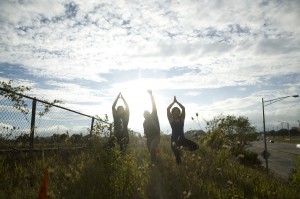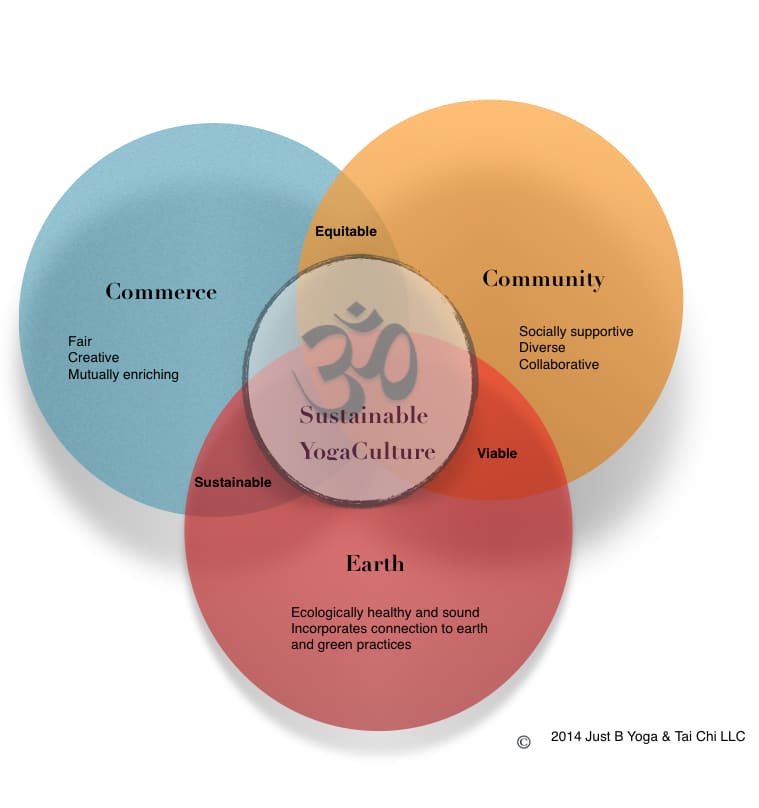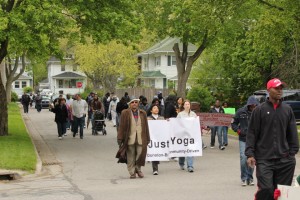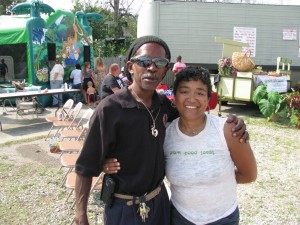What’s possible when we elevate the vision of yoga beyond asana outside of the studio doors? Where do you see your yoga signature in your city or town? What is yoga’s duty to community?
(I will be presenting on this topic at a workshop at the Michigan YogaFest at the end of this month. I hope this generates vibrant and healthy discussion and debate. I will incorporate feedback from your reactions into the final presentation)
When Just B Yoga began in 2010 as a once-a-week free community yoga class, Michigan was digging out from the recession. Indeed we are still digging, recreating and re-“vision”ing the future of our state.
The effects of the “Great Recession” left us poorer, disenchanted, disempowered and depressed.
It was in this soil in the state capital that we planted the idea of a yoga and tai chi studio that would offer classes based on “what’s in your pocket or in your heart.” Our mission was to remove the barriers or excuses to exploring the practice of yoga.
“I can’t afford it.”
“It’s not for my _______(race, body-type, age, sex/gender identification)”
“It’s not near where I live.”
Thus we started to grow what I call a Sustainable YogaCulture. It’s an inter-connected and inter-dependent system of conscious commerce, diverse social interaction and environmental stewardship. Yoga became more than an asana commodity, stripped of its other seven limbs. It is a whole system of practice integrated into how we interact with our greater Lansing community.

I will share this concept with you and offer tips and suggestions to help cultivate a Sustainable YogaCulture in your town. In exchange, I ask for you to share your experiences, your constructive feedback and research.
Yes, we are a full-time yoga studio with classes every day, including workshops and trainings. We offer yoga for bigger bodies, older bodies, LGBTQ bodies; basics, power, Yin, esoteric and chakra-focused classes. We’ve trained in special needs yoga, yoga for substance recovery, eating disorders and trauma.
But beyond the asana, the mats, and the props, the studio itself is a community anchored not to the pillars of yoga business, but community outreach, service and investment. Just B Yoga is growing into a community organization, community garden, social activist, arts venue and gathering place. We network with non-yoga organizations – art galleries, nonprofits, government agencies, schools, neighborhood watch, multimedia companies, environmental groups and more. Their cause is ours. Those connections, that union – is what sustains and propels us.
Sustainable YogaCulture is a fledgling idea that I hope can grow into the next frontier for yoga in our communities.
Go beyond the “yoga industrial complex”
Right now, Sustainable YogaCulture is a notion, a tickle in the back of my head before I go to sleep at night.
It taps me on the shoulder when I see yoga selfies on Facebook. It nags me when I see words like “Yoga Challenge.” It shames me who I’m reminded I once considered creating a fundraising event called “Yoga Battle.” It glares at me from magazine ads for Lululemon, Hard Tail or Hugger Mugger. It makes me cringe when someone is referred to as a yoga “rock star.”
Today’s yoga landscape seems a far cry from the 1970s mainstreaming of yoga on PBS with “Lilias, Yoga and You.”
Now, it’s a $27 billion yoga industry with more than 30,000 yoga studios and teaching schools. The bulk of pie goes toward the yoga supply chain (clothing, yoga mats, DVDs ) not the teaching of the actual yoga asana, much less meditation, breath or any other limbs.
Like agriculture, the shape and form of mainstream popular yoga is manipulated, dominated and engineered by a yoga industrial complex that prioritizes physique and profits over prana. The most popular yoga types are fitness-based: Hot Yoga, Bikram, Vinyasa and Power. See this yoga industry report.
But is the fitness “yoga industrial complex” healthy, nourishing and sustainable? Rip and tear, grin and bear, suck it up and no pain no gain is not a long-term practice.
Can we create Sustainable YogaCulture?
It seems a natural fit to mirror sustainable agriculture, which rejects industrial approach to food production.
Just like agriculture this yoga industrial complex has made yoga abundant but often with a steep price. The yoga industry has alienated populations, has marginalized some types of yoga and their benefits, smaller operations have a harder time succeeding because of being pushed out of the “market”, the impact of the yoga products and studios could be kinder to the earth and our immediate environment. The sustainable philosophy would also support fair and treatment of yoga employees and staff and pricing that provides the instructors livable income and that’s affordable for the yoga student.

Can we strive for it to be:
- Economically equitable
- Ecologically healthy and sound
Sustainable agriculture has gained momentum and success in greening urban blight, decreasing food deserts, heightening awareness of healthy food choices, created new economic revitalization across many communities in the country, which supports those who grow the and sell the food.
Economics, social connections and the environment are just as important for yoga culture, NOT yoga business.
In biological terms a culture “maintains (tissue cells, bacteria, etc.) conditions suitable for growth.”

Sustainable YogaCulture is an investment in future yoga practice, like a crop of grain, ensuring its health, vitality and viability now. Let’s not limit the vision but rather expand it.
In “What the future holds”, the author writes: Already yoga is moving out of the studio and into schools, prisons, corporate offices, and hospitals. How much further will it penetrate American life?
Just B Yoga’s experience has shown me that the more diverse and inclusive we are to the greater Lansing community, not just the yoga community, the more sustainable our efforts are.
Socially supportive
Let’s call this the “who and where” of our yoga.
Where is your studio located? What is the racial, age, financial makeup of those who attend your studio?
Just B Yoga is literally on the other side of the railroad tracks.

Our studio space is humble but clean and accessible. People can ride their bikes to class, ride the bus or even walk.
Eighty percent of our students pay the suggested donation or more. We need those who can pay to help subsidize those who can’t. But it’s not a yoga charity.
Can your studio and should it reflect your the demographics of your geographic region?
Lansing is 23% Black, 24.5% with a bachelor’s or higher degree, with a median household income of $37,128 and 27% live below the poverty level.
Just B Yoga’s client base is:(based on a January 2014 survey of students) 20% have a household income of $20,000 or less; 59% live in the city of Lansing; 44% have an undergraduate degree or higher; 10% are non-white.
Break down the walls
Are your studio walls inviting people in or keeping them out?

Traditional structures like ashrams and retreats need to give way to inclusive ways of being, or at least make room for. And that involves our thinking too.
The more isolated or exclusive the setting like Omega Institute, Kripalu, Yogaville and others doesn’t make it better. Holding these facilities above perpetuates the stereotype of yoga as elitist, affluent, extreme and unaccessible.
This is no judgment of the practice and the level of deepening that separating from the distraction of life can offer.
But if you do need to have walls, where did you choose to put them? What communities are you serving? Can you broaden your reach?
Then let’s think out of the box! How about a yoga mobile that goes from location to location? When Just B Yoga was just a year old we did a traveling “Yoga Around Town” choosing a different location each time, once a week. This exposed

people to new neighborhoods and sights, and it also brought the yoga to the neighborhoods (removing accessibility as a barrier to yoga).
How about yoga delivery services?
The internet age has certainly started to equalize access so that some who don’t have a local studio can be exposed to different types of practice. But we can and should go farther. The internet is still not accessible to all and what’s being offered online is still very white and privileged.
Socially active and involved
And finally how does your yoga support community? Where are you participating as individuals and as a group? Peace marches, vigils, demonstrations, public hearings.

Is your studio participating in movements in your town? Economic, educational, environmental? Writing a check is great and one way to show support.
Support your local community, partner with other community organizations.
We are seeing a rising movement of community involvement by yoga studios
Harlem Yoga Studio has innovative partnerships with organizations and agencies in New York. Grateful Yoga in Evanston, IL – does karma yoga donations, silent auction donations, cooking classes and therapy yoga for neglected and abused children and more.
Yoga Shelter in Detroit has outreach with charities.
Are there deeper and more meaningful ways to set the tone be socially active? Are you sponsoring causes, spearheading movements beyond your studio walls?
How does this level of social interaction and collaboration help? First it’s free publicity. People saw your organization’s banner flying.
Second, you invest in some shoe-leather equity, walking the mile in your neighbor’s shoes.
Third, your community sees you as a person, a neighbor and invested in them!
We are asking our communities to invest in us. To give us their hard-earned money. When do we give back and what does it look like?
Yoga to Yoga
Being socially supportive also involves ourselves.
Who do we interact with in our yoga practice? Who do we invite? Who do we serve?
Do you know the owners of the other yoga studios in town? Do you know most of the instructors? Have you extended an olive branch to create a united yoga community?
Too often we’re in the silos of our lineage or type of yoga. Maybe we’re completely devoted to our yoga teacher.
Can we recruit each other for a single event and eventually grow to create a dynamic relationship that’s cooperative and collaborative and not competitive? Some yoga communities plan their yearly events in order not to have overlap, allowing students to not have to choose between events and rather be able to attend them all. Some studios close in order to attend another studio’s event and they reciprocate in kind.
Conscious commerce and non-hoarding (aparigraha)
Note that Sustainable YogaCulture is not sustainable yoga-nomics. Most yoga studios in business to make money. Period. And not just money but profits. Even yoga-for-a-cause events often only siphon a small percentage to the cause.
Yoga has risen into the mainstream on the wave of yoga pop culture. We’ve made celebrities of yoga instructors and celebrities themselves turn into yoga aficionados and spokespeople.
Successful yoga means fame and fortune. So yoga studios around the country are shaping their look and their price tags to fit that mold.
Most yoga studios have a minimum of $15 drop-in rate for a class. Workshops are in the hundreds. Teacher trainings are in the thousands, sometimes tens of thousands.
In “Why yoga is a broke A- – business” the author writes: “I want to end with this: We teach mindfulness to our students but the truth is that we have to be more mindful as an industry.
I don’t have a solution. But I am very conscious of how I spend my yoga dollars. Every. Single. One.
I practice at my local studios and I buy their stuff whenever I can. I attend one or two festivals a year where I take my yoga dollars outside of a studio (I’m not being judgmental; it’s just not my thing. I’m more of an introvert and practice yoga inward, not outward.).
I make exceptions in my pay for small studios that offer more personalized yoga, which could very soon be a thing of th
e past. I drive a long way to teach a small class of yogis who are looking for something unique, and that makes me happy if not rich.
At some point, the broke-ass teachers need to help the broke-ass yoga studios, and the festivals need to give back to the broke-ass communities. And the stores which offer free yoga to sell their clothes just need to stop. We are all in this together, and if we suck the life out of yoga, dollar by dollar, then there will not be an industry left to revive.”
We also need to be mindful of what we’re selling. Are we selling a popular trendy thing to be exhausted? Or something unique and local?

Just B Yoga strives to emphasize the connection we have as a part of the Lansing community. Identifying with a revitalization movement called #LoveLansing, we support local business and innovation.
Our asana practice is also very accessible – real people yoga. We aren’t swinging from the ceilings or arm-balancing on a surfboard. (Not that that doesn’t sound cool) We want our students to see the person they see in the mirror doing yoga.
Make the exchange of currency or equity or eggs mean something.
From “Sacred Economics”: “When life is full of such things, made with care, connected by a web of stories to people and places we know, it is a rich life, a nourishing life. Today we live under a barrage of sameness, of impersonality. Even customized products, if mass-produced, offer only a few permutations of the same standard building blocks. This sameness deadens the soul and cheapens life.”
I do know there are many studios teaching beautiful practices in asana, mindfulness, philosphy and more. How do we expand those practices and make them more accessible and available to more of the general population?
Sometimes the pocket is where it needs to start.
You can explore donation-based models like our own.
Possibly create a yoga scholarship fund or sponsorship program to offer those in need an opportunity to practice.
Creating a full yoga cooperative is another option.
Outside of yoga there is a rise in alternative commerce and currency – trades, barters and couch surfing.
Sustainable YogaCulture offers free and fair trade, not exploiting anyone or cheating anyone. Maybe that’s in the form of sweat equity. Maybe it’s in the form of eggs.
I don’t believe we should give all yoga away for free. We diminish the value of this ancient practice.
The giving and taking of the instruction should be fairly exchanged. The teachers are giving of their time and energy and spirit to share this practice.
Some teachers can live off teaching, others are barely eeeking by.
Recreating our commerce models to bring balance and equity for all parties should be the goal.
Can we start to develop and experiment with more conscious commerce than capital gain?
Environment

Our practice cannot sacrifice our mindful attention to the environment. Indeed we need to incorporate more elements of the outside world within our practice.
Not everyone can make their studios LEED Certified, nor can they install solar panels. It’s awesome if you can. But there are many ways to get down to earth with your studio’s engagement and relationship with the earth.
Just B Yoga has been cultivating a community garden for the last three years. We’’re members of The Garden Project of greater Lansing and have even held farmer’s market days so local farmers can sell their produce to the yoga community and residential neighbors.
Just B Yoga is in a food desert. For many locals without transportation, access to food is at the local convenience store.
Even if neighbors never come inside to roll out a yoga mat for asana, they are participating in yoga with us sharing in cultivating our garden or buying locally-produced fruits and vegetables.

Can your studio sponsor a plot in a local garden? Can you hold food workshops and gardening workshops? Can you build your own greenhouse?
Jacky King, of King Karate, created an organic garden in Flint that not only produces food but teaches teens the business of farmers markets and exposes at-risk youths to greenery. The students even practice some of their katas in the greenhouses, being surrounded by greenery and life.
Connecting with environment loops back to being socially supportive. Working with environmental group and gardening groups further entrenches us into community.
Participate in river or stream cleanups or trout and salmon releases.
Adopt a highway or roadway.
Recycle yoga mats or re-purpose them with a crafting event for kids.

Does your studio participate in smart commute days or events? Do you have a bike rack? Do you reward those who use alternative modes of transportation to come to your classes?
This is more than a symbolic gesture. This is fully and holistically bringing practice into our practical lives, walking the walk that we talk.
Where to start in your hometown at your home studio?
Takeaways and Tips:
Placemaking.
Is your studio helping build a sense of place in your community? Michigan is in a Renaissance. Every city. How are you making your role and presence felt in a positive way beyond asana? How do you help make your town a destination and your studio a destination within your town? Who do you need to learn from, collaborate with, invest in?
Know your community.
What’s going on in your community? Is there a person who is battling a rare disease? Is there a new innovation coming to town? Are there social movements gaining steam? Is the budget so bad the state is considering an emergency manager? Who are the movers and shakers in your town and do they know who you are? What is your studio’s connection to the local community as residents, parents, teachers, employees? Then what’s your relationship as yogis?
Join, join, join.
Do you only belong to yoga organizations? That’s a very insular existence. Join the chamber of commerce, visitors bureau, neighborhood watch, neighborhood association, local nonprofits (sit on the board).
Join neighborhood festivals and annual events.
Coordinate your own.
Partner.
Partner with other organization you support or admire. Find organizations where you can align your missions.
Creative business-to-business partnering opens exposure to potential new yoga students.
Storytelling.
What is your yoga studio’s story? What are your students’ stories – beyond studio practice? What brought them to their yoga? What are their talents? What are their connections to community and why are they at your studio specifically? How can you tell those stories tastefully to create connection with others beyond your studio walls? Humanize the yoga. Let our neighbors see our yoga beyond twisting our bodies. When they see themselves in us, we are one sangha.
Namaste.
Belinda Thurston is the founder of Just B Yoga & Tai Chi LLC. She is a speaker and writer (former 20-year journalist). She has presented talks two years in a row at the Building Michigan Communities Conference and will present on “Service, Sacrifice and Selflessness” at the 9th Annual Michigan Homeless Summit in September.
Copyright © 2014 Just B Yoga & Tai Chi LLC
All rights reserved. No part of this publication may be reproduced, distributed, or transmitted in any form or by any means, including photocopying, recording, or other electronic or mechanical methods, without the prior written permission of the publisher, except in the case of brief quotations embodied in critical reviews and certain other noncommercial uses permitted by copyright law. For permission requests, write to Belinda Thurston at belinda@justbyoga.com